Home | Front Page | Index | Blog | New | Contact | Site Map
Lake Peten Itza
Tikal
Coban
Guatemala City
Lake Atitlan
Markets
Antigua
Rio Dulce
Esquipulas
Mundo Maya
Foto Show
More About Coffee
Coban, Guatemala
San Pedro, Guatemala
Cafe Britt, Costa Rica

Central America
Route Maps
Belize
Honduras
Nicaragua
Costa Rica
Panama
Mexico 2003-04:
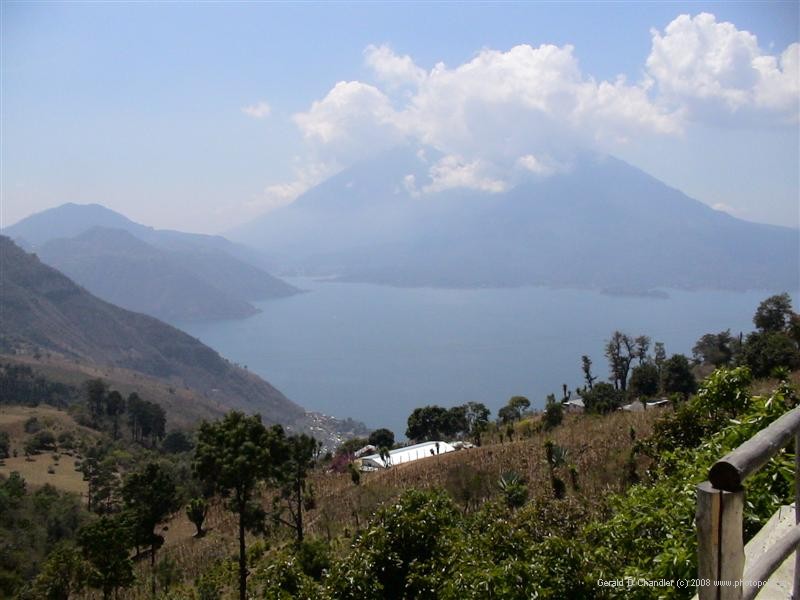
Lago de Atitlan from Approach Road |
After five days in Guatemala city we drove 102 km (65 miles) west through mountains to Lago de Atitlan. About halfway there the road splits. The longer, un-taken, and we think faster road, goes north, swings around through the provincial capital of Solola, and comes back five miles to Panajachel (pan-a-hach-el), the main town on the lake. Instead we took the shorter, southern branch, over which we hardly averaged 35 km/hr due to the major ups and downs of the road as it winds its way through volcano country and their remnants. It was very beautiful country, averaging 2000-2500 m in elevation. Fifteen kilometers before we reached Panajachel the road began to border the lake, 500m above it. We had a wonderful view, which we lingered over by stopping for lunch at a small restaurant which hangs above the lake.

Hotel Tzanjuyu, Lago de Atitlan |
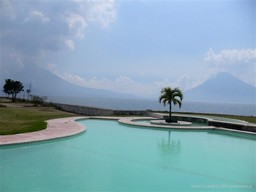
Swimming Pool, Hotel Tzanjuyu |
In Panajachel we took a room in Hotel Tzanjuyu, an old, badly maintained hotel, with a fantastic view of the lake (about 10 km in diameter) and the three major volcanos that are a southern backdrop to it. The highest is 3,800 m (12,500 ft). A plus of our place was its very nice swimming pool. We went in several times and much enjoyed it in spite of the fact it was always cold (we tend to forget that technically it is winter by northern reckoning); unfortunately we often had to wait until late in the day for the town high school swimming class to end. We suspected that once upon a time the hotel had been for the exclusive use of government officials. Now it was trying, not very successfully, to make it as a private enterprise. But our room was fine with a small balcony and a spectacular view of the lake and the volcanoes beyond.
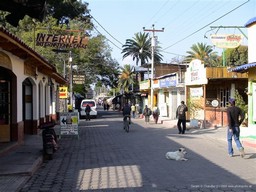
Downtown Panajachel |
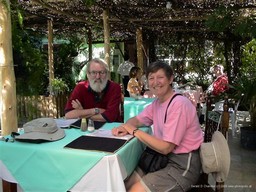
Panajachel's Place for Great Pancakes |
Panajachel, or at least the center (about 4 blocks by eight), is very tourist-oriented. Lots of restaurants with good food at good prices. Gerry was happy to find a garden restaurant that made great pancakes, nearly as good as Denny's. We had several set meals with entry, vegetables, and salad, for Q20 (20 quetzals, about $2.50). There seems to be a small crowd of American retirees in town; we liked it better than Mexican towns that draw large number of retirees but still it wouldn't be our first choice for a retirement home.
Up the street from our hotel, only a little bit, we ate at another hotel-restaurant complex, also very much run down. The most interesting thing about it was a bronze plaque on the grounds that says it was built so that workers could have a place of rest. That sounded to us like old Soviet propaganda. We have no proof, but the obvious former quality of the place makes us think that, like our hotel, it was mostly government bigwigs — or rather their families — who used the place. Now with a market economy newer, better places are available.
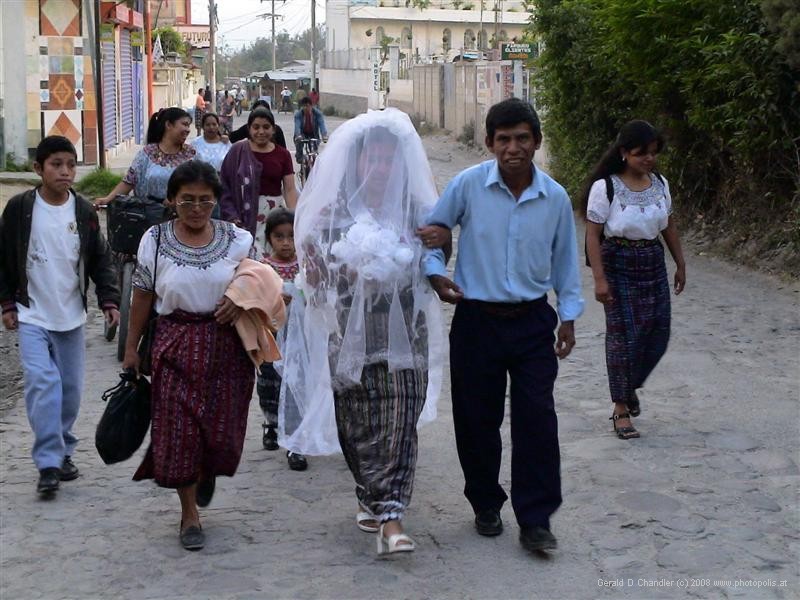
Panajachel Wedding Party |
We made two outings to explore villages on the shores of Atitlan. Our first trip was a walk along the shore southeast to Santa Catarina Palopo, a distance of about 5 km. At many places along the shore overlooking the lake we saw new, upscale homes being built. This must be due, at least in part, to the new accessibility due to the paving of the road. The village is a center of back-strap weaving and there are plenty of stalls selling their colorful product. While we were in Santa Catarina we saw small groups of tourists who had arrived by boat; we imagined how much more isolated and romantic the place must seem (like Lamanai in Belize) to arrive by water rather than by land. Perhaps the most interesting thing about the day was that when we were almost back to Panajachel we met a wedding party walking to church. The young bride, dressed in traditional costume but with a white veil, was led by her father, and the rest of the family, including a tiny bridesmaid, walked behind.

The Boat to San Pedro |
After several false starts, including two trips away from the lake, we took a launch across the lake to explore San Pedro de Laguna and its surrounds. San Pedro is said to attract and house lots of hippies and that you can't help but be offered marijuana. It is also a coffee-growing area and in the village surrounds we got to watch some coffee being peeled, washed, and sorted. Overall San Pedro didn't appeal to us at first sight, though not because we weren't offered any weed. It simply has much less to satisfy our desires of comfort and cleanliness than does Panajachel. One hotel had been highly recommended to us by travelers we met in Mexico. We sought it out, having to find our way through corn fields and coffee orchards. While we liked it and its surroundings it didn't quite meet the superlatives we'd heard. Overall we were glad to be in the Tzanjuyu, although it and its pool did admittedly cost more than San Pedro.
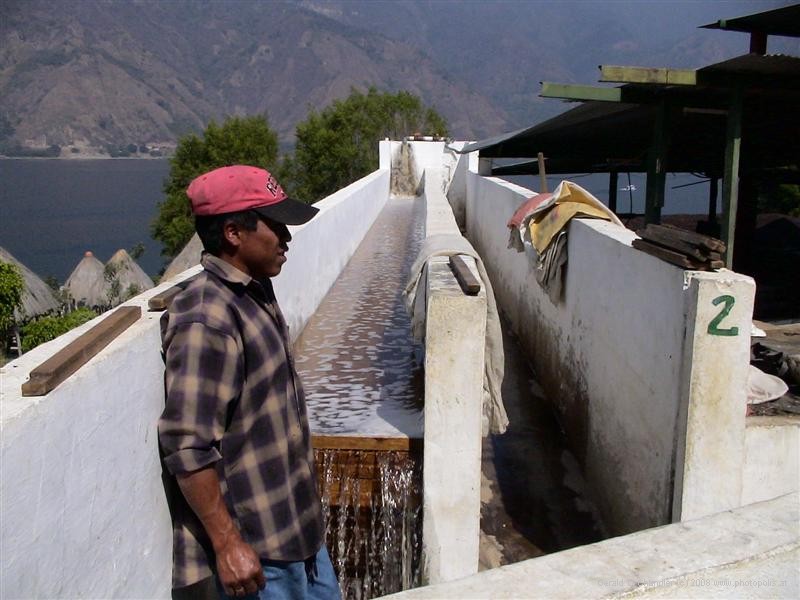
Washing Coffee in San Pedro |
For us, San Pedro was also memorable for a brief conversation we had there with a British traveler. A woman, about 50, she was traveling in Central America alone which we thought was pretty gutsy. We talked first of all about Guatemala then about her recent trip to Cuba. We were rather shocked in the middle of the conversation to hear her say that Cuba's plight was the fault of "your government"! We retorted that on the contrary, it was the fault of the Cuban dictator Castro and the coterie of extreme left-wing communists that helped to keep him in power by force. She was as shocked by our reply as we had been by her accusation. She had probably never met an American who disagreed with her point of view, which we have heard from several Cuba visitors and suspect is the product of Cuban propaganda.
From San Pedro we'd planned to walk around the lake's southwest to San Juan and then to San Marcos, something we thought would take 3 hours. When we approached San Juan we met a British group walking from volcano to volcano around Guatemala to raise funds for charity. They'd been on the road about five days and had five to go. They were accompanied by a Guatemalan policeman who told us that walking to San Juan was safe but that beyond it the danger of robbery was high. Caution overcame curiosity and we limited ourselves to San Juan.

Sleepy Village Square, San Juan |
San Juan is remarkable only because it was a quiet, peaceful place, neither much affected by the hippie life 3 km away in San Pedro nor by the more upscale tourists in Panajachel. This can't be exactly right, since many of them must go to these places to work and the funds they bring back do change their life. But the streets and shops certainly had none of the bustle of the two tourist towns mentioned and we were the object of amiable curiosity rather than a target for handicraft-selling children. For a while we just sat on a curb and watched. We were rewarded with seeing the town drunk stumble about and seeing parents go to the school and shortly come back with youngsters in tow.
On the 45-minute boat trip back we met and talked with a French couple from Nantes, he a psychiatrist and she a nurse. They work intensively, about 12 hours a day, for two months and then take the third month off. Thus they go to some place remote for a month four times a year. There are always new ways to see the world!